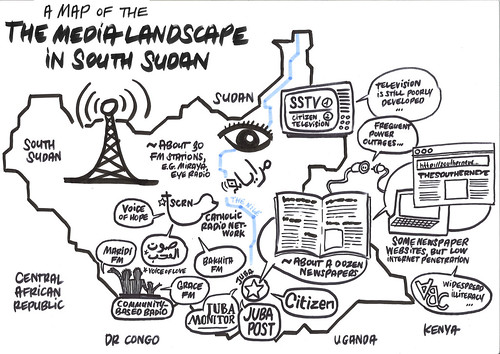A look at ICT happenings in South Sudan as the young nation heads into its third year of independence
July 9th, 2013 marked two years of South Sudan’s independence from Sudan. Many challenges lie ahead – most notably insecurity and a weak economy. ICT remains lacking as well in the rural nation.
Given the state of South Sudan’s economy, we’ve found a surprisingly high number of stories relaying news of Internet progress in the country over the past year. Key challenges include the decentralized nature of the population, a lack of government regulation, and expensive internet access.
The government is taking a series of notable and impressive steps to promote top-down internet access. They include pushing a country-level domain, creating a telecoms regulatory authority, investing in fibre instead of VSAT for long-term savings, and discussing open source solutions to problems. Much of the success of these initiatives will no doubt hinge on South Sudan’s ability to capture oil revenue from the north or find new sources of revenue.
Our chronological notes on South Sudan’s internet (June 2012 – June 2013):
- The #OSJUBA event in June 2012 discussed how to make Juba an open source city
- The country is creating a telecommunications regulatory body (as of June 2012)
- MTN and Zain planned on launching mobile money services in 2012 due to demand from NGO, government, and business sectors (this does not seem to have happened)
- The government, who had been paying 20,000 euros per month for VSAT access, wants to utilize neighboring fibre optic cables instead with the expectation of twice the speed at half the cost
- Ericsson was to provide ICT solutions to select schools in South Sudan in conjunction with the global education initiative Connect To Learn
- Yahsat announced plans to bring satellite broadband to parts of the country using RCS-Communication as the main ISP
- The “Media & Makers Juba 2012: Open Knowledge and Sustainable Media Forum” (held from December 11-13, 2012) built upon the #OSJUBA conference held earlier in Berlin
- United Nations High Commissioner for Refugees (UNHCR) is using satellite imagery, interactive mapping, digital fingerprinting, and text messaging to strengthen refugee protection
- The average retail price of Internet bandwidth via satellite was around $4,000 per megabit in 2012
- The country has 15 total ISPs but four main mobile operators: MTN, Zain, Vivacell, and Gemtel – all rely on either VSAT, or WiMAX technology for internet services
- A .ss domain suffix will be ready in 2013 for use by both government and private sectors
- SIM card registration concluded on 28 February but compliance was reportedly low
- Mobile operator Zain has explicitly stated challenges remaining profitable in the country, where the market is essentially saturated due to a small and hardly-changing economy (plus Zain doesn’t hold a formal license for South Sudan, per se)
- The Pan-Africa e-Network Project, funded by the Indian government, hopes to develop e-government projects including tele-education
- At the May 2013 Stockholm Internet Forum, one participant from South Sudan bemoaned online fighting amongst Sudanese and another wished debate would focus on quality of internet instead of quantity
- An unverified government Twitter account @repsouthsudan was launched in 2011 after South Sudan became independent and now has 6,400 followers
- Employees from Gemtel had a stand at the East African Communications Organization (EACO) Congress in June 2013
- O3b networks, through ISP RCS-Communication, will bring lower latency satellite internet to customers in Juba
- News from the Government of South Sudan can currently be found at GOSS.org













 Twitter
Twitter Facebook
Facebook Pinterest
Pinterest